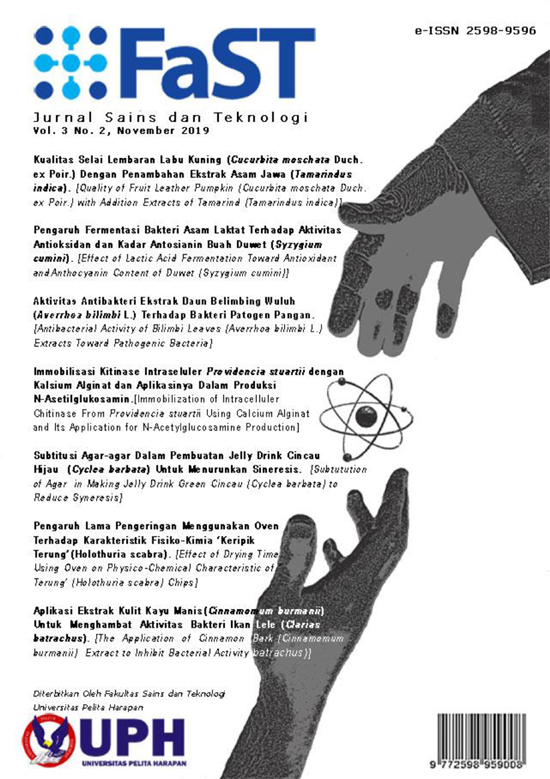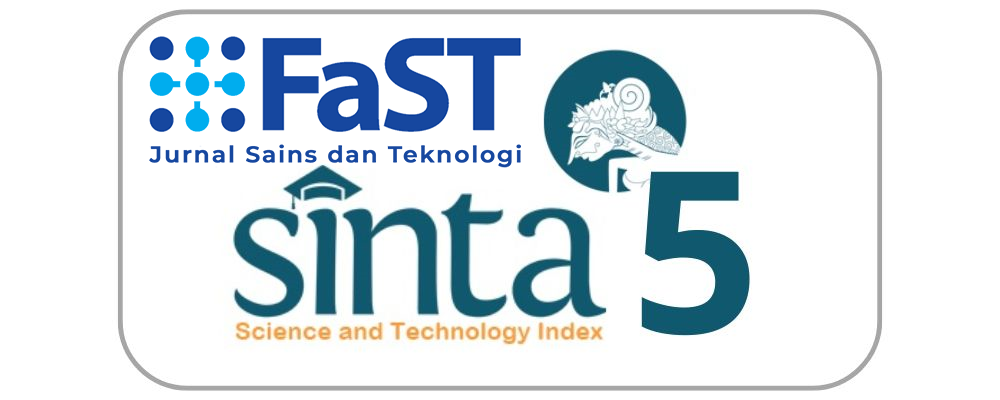KUALITAS SELAI LEMBARAN LABU KUNING (Cucurbita moschata Duch. ex Poir.) DENGAN PENAMBAHAN EKSTRAK ASAM JAWA (Tamarindus indica)
Keywords:
Antioxidant, Tamarindus Indica, Cucurbita moschata Duch. Ex Poir. Fruit leatherAbstract
Tamarind is fruit that has an acid pH that support the gel formation process. Processed products that require acid to make the structure of the gel are sheet fruit leather. Tamarind extract will produce a product that is less attractive in terms of taste or color, so it needs to be combined with pumpkin which has a yellow color. Tamarind and pumpkin are foods that have high antioxidant content which is very beneficial for the body. This aims to find out the effect of adding tamarind extract (Tamarindus indica) to the manufacture of pumpkin fruit leather (Cucurbita moschata Duch. Ex Poir.) so that it can produce the best and most preferred physical, chemical, microbiological and organoleptic fruit leather. The design of the study is completely randomized design (RAL) with 4 factor that is (100 % pumpkin : 0 % extract of tamarind), A (87,5 % pumpkin : 12,5% extract of tamarind), B (75 % pumpkin : 25 % extract of tamarind) and C ( 68,5 % pumpkin : 32,5 % extract of tamarind). The parameters tested were water content, ash content, crude fiber content, soluble fiber content, total dissolved solids, titrated acid total, total phenolic, antioxidant activity, product hardness, product color, total plate number, yeast mold, and organoleptic test. The results showed that there were significantly different effects on the quality of fruit leather which included water content testing, ash content, total dissolved solids, crude fiber test, soluble fiber test, total titrated acid, total phenolic test, antioxidant test, texture and color, but did not give a significantly different effect in terms of microbiological tests in the form of total plate numbers (ALT) and yeast molds. The quality of pumpkin fruit leather with the addition of the best tamarind extract is the treatment C ratio of 62.5% pumpkin: 37.5% extract of tamarind, both in terms of the best quality in terms of chemical, physical, microbiological and organoleptic.
References
Aini, N., Purwono, B., dan Tahir, I. 2007. Structure antioxidant activites relationship analysis of isoeugenol, eugenol, vanillin and their derivatives. India Journal Chem 7 (1) : 61 - 66. AOAC. 1995. Official Methods of Analysis of The Association of Analytical Chemists. Washington: Benjamin Franklin Station. AOAC. 1999. Official Methods of Analysis of The Association of Analytical Chemists. Washington: Benjamin Franklin Station. AOAC. 2005. Official Methods of Analysis of The Association of Analytical Chemists. Washington: Benjamin Franklin Station. Aritonang, 2013. Pengaruh konsentrasi pektin dan kosentrasi asam sitrat terhadap karakteristik selai lembaran labu kuning (Curcubita moschata). Bandung: Artikel. Fakultas Teknik. Universitas Pasundan Bandung. Astuti, S.D., dan Agustia, F.C. 2014. Formulasi dan karakteristik minuman jeli fungsional sumber serat pangan dan vitamin C dari kappa karagenan, konjak glukomanan dan ekstrak asam jawa. Purwokerto: Skripsi. Fakultas Pertanian. Universitas Jendral Soedirman Purwokerto. Caluwe, E.D., Halamova, K., dan Damme, V.P. 2014. Tamarind (Tamarindus indica L.): A review of tradisional Uses, phytochemistry and pharmacology. California: University Of California Santa Cruz.. deMan, J.M. 1997. Kimia Pangan. Bandung : Institut Teknologi Bandung Press. Departemen Kesehatan RI. 2001. Daftar Komponen Bahan Makanan. Fachruddin, L. 1997. Teknologi Tepat Guna Membuat Aneka Selai. Yogyakarta: Kanisius. Fardiaz, S. 1993. Mikrobiologi Pangan. PT. Jakarta: Gramedia Pustaka Utama. FCM Crop. 1997. Carragenan: Marine Colloid Monograph Number One. New Jersey : Merine Colloids Division FMC Corporation Springfield. Glicksman, M. 1983. Food Hydrocolloids Volume II. Boca Raton Florida: COC Press Inc. Hawley, G. G. 1981. The Condensed Chemical Dictionary. 10th Edition. New York : Van Nostrandreinhold Co. Inc. Jarrett, T.N. 2012. Acids in Confections. The Manufacturing Confectioner, New York. Kusmayanti, N.A., Rosiyani, F., Freitag, H., dan Sudargi, T. 2014. Pola Makan dan Obesitas. Yogyakarta : Gadjah Mada University Press. Lattimer, J. M. dan Haub, M. D. 2010. Effect of dietary fiber and its components on metabolic health. Journal Nutrients 1 (2) 1266 -1289. Lee, K.W., Kim, Y.J., Lee, H.J., dan Lee, C.Y. 2003. Cocoa has more phenolic phytochemical and a higher antioxidant capacity that teas and redwine. Journal Agric Food Chem 51 (125) : 7292 - 7295. Majon, F., Poursaeed, M., Mehrgan, H., Dan Pakdaman, S. 2008. Antibacterial activity of thyamus daenensis methanolic extrac. Pakistan Journal of Pharmaceutical Science 2010-2013. Muchtadi, T., Sugiyono., dan Ayustaningwarno. 2010. Ilmu Pengetahuan Bahan Pangan. Bandung : Penerbit Alfabeta. Muchtar A.F. 2010. Be Healty Be Happy. Jakarta Barat : PT Bhuana Ilmu Populer. Noviani, N. 2018. Pengaruh konsentrasi pektin dan gula terhadap selai lembaran campolay (Pouteria campechiana). Bandung : Skripsi S-1. Fakultas Teknik. Universitas Pasundan Bandung. Nurlealy, E. 2002. Pemanfaatan buah jambu mete untuk pembuatan leather : kajian dari proporsi buah pencampur. Malang : Skripsi S-1. Fakultas Teknologi Pertanian. Universitas Brawijaya. Osundahunsi, O, F., Amosu, D. dan Ifesan, B.O.T. 2007. Quality evaluation and zcceptability of soy-yoghurt with different colours and fruit flavours. American Journal of Food Technology 2 : 273-280. Parthasarathy, V.A., Chempakam,B., dan Zachariah, T.J. 2008. Chemistry of Species: Tumeric and Tamarind. London : CAB Internasional. Pratiwi, U., Harum, N. dan Rossi, E. 2016. Pemanfaatan karagenan dalam pembuatan selai lembaran labu kuning (Curcubita moschata). Jom Faperta 3 (2) : 1-8. Ripi, V.I. 2011. Pembuatan dan analisi kandungan gizi tepung labu kuning (Curcubita moschata Duch.). Jawa Timur : Skripsi. Fakultas Teknologi Industri. Universitas Pembangunan Nasional. Rukmana, H.R. 2005. Asam. Yogyakarta : Kanisius. Sandjaja, A. 2009. Kamus Gizi. Jakarta : Kompas. Singh, J., Singh, V., Shukla, S., dan Rai, A.K. 2016. Phenolic contect and antioxidant capacity of seleced cucurbit fruit extracted with different solvent. Journal Of Nutrition And Food Sciences 6(6) : 2-8. Standar Nasional Indonesia. 1992. Cara Uji Makan dan Minuman SNI 01-2891-1992. Jakarta : Badan Standardisasi Nasional. Standar Nasional Indonesia. 2008. Selai Buah SNI 3746: 2008. Jakarta : Badan Standardisasi Nasional. Tamer , C.E., Ncedayi, BI., Yonel, S.P., Yonak,S., dan Copur, O.U. 2010 Evaluation of several quality criteria of low calorie pumpkin dessert. Notulae Botanicae Horti Agrobotanici Cluj Napoca 38 : 68 - 80. Torio, M.A.O., Saez, J., dan Merca, F.E. 2006.Physicochemical characterization of galaktomannan from sugar palm (Arenga saccharifera Labill.) endosperm at different stages of nut nuturity. Philippine Journal Of Science 135 (1 ) : 19 - 30. Widarta, I.W.R., Suter,I.K., Yusa, N.M., dan Arsandhi, P. 2015. Penuntun Praktikum Analisis Pangan. Bali : Universitas Udayana. Safriani, N., Husna, N.E., dan Rizkya, R. 2015. Pemanfaatan pasta labu kuning (Cucurbita moscahat) pada pembuatan mie kering. Jurnal Agroindustri 5 (2) : 85 - 94. Muzaffar, K., Sofi,S.A., dan Kumar,P. 2018. Comparative study of ripe tamarind buah and spary dried tamarind buah powder for compositional analysis. Internasional Journal of Advance Research in Science and Engineering 7 (4): 754 - 761. Manab, A., Sawitri, M.E., dan Awwaly,K.U.A. 2017. Edible film protein whey. Malang : UB Press. Obongoya, B.O., Wagai, S.O., dan Odhiambo, G. 2010. Phytotoxic effect of selected crude plant extract on soil borne fungi og common bean. Afican Crop Sci Journal 18 (1) : 15 - 22.
Downloads
Published
Issue
Section
License
“Authors who publish with this journal agree to the following terms:
1) Authors retain copyright and grant the journal right of first publication with the work simultaneously licensed under a Creative Commons Attribution License (CC-BY-SA 4.0) that allows others to share the work with an acknowledgement of the work's authorship and initial publication in this journal.
2) Authors are able to enter into separate, additional contractual arrangements for the non-exclusive distribution of the journal's published version of the work (e.g., post it to an institutional repository or publish it in a book), with an acknowledgement of its initial publication in this journal.
3) Authors are permitted and encouraged to post their work online (e.g., in institutional repositories or on their website). The final published PDF should be used and bibliographic details that credit the publication in this journal should be included.”



